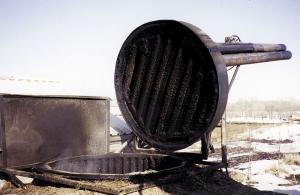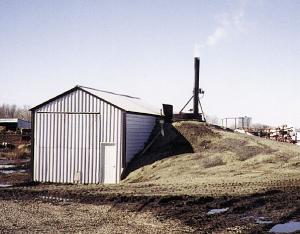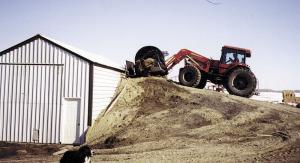1998 - Volume #22, Issue #5, Page #09
[ Sample Stories From This Issue | List of All Stories In This Issue | Print this story
| Read this issue]
Underground Big Bale Furnace Heats Home,Shop
 |
 |
 |
To get away from electric heat, the Russell, Manitoba, father and son team took a look at commercial bale burners but found they couldn't justify the expense. Instead, they built their own big round bale burner completely from scratch.
"We now burn about 40 5 by 6-ft. round bales of flax straw a month in the coldest weather to heat our shop and two houses," says Duane. "We make the bales ourselves so the cost of running it is practically nothing and we can load it in minutes with a front-end loader."
The bale furnace is buried in an earth berm next to a 16 by 32-ft. shed. It has a 6-ft. dia., 9-ft. high firebox that's designed like a giant cage, with 48 vertical pipes made out of 2 in. sq. tubing spaced 2 in. apart around the out-side. It has a 3-ft. deep ash pan underneath and a lid with two 8-in. dia. smoke stacks made of 1/8-in. wall pipe on top.
The shed houses the furnace's controls, pumps and 200-gal. water storage tank and provides access to the ash pan. The furnace was built next to the shed and then dirt was backfilled around it to insulate it and also to make it easy to load.
Water is pumped through the burner by two 1/16 hp pumps. It's heated to 140 to 160 degrees by the burning bale and then returned to the tank where it's stored until needed.
Two additional 1/16 hp pumps move water to the Klimacks' 48 by 56-ft. shop, which has radiant floor heat, and also to both Clarence and Duane's homes. Like the shop, Clarence's 1,200 sq. ft. home has radiant floor heat and Duane's 1,100 sq. ft. home has forced air heat, which required a radiator to be installed in the duct work. Hot water from the bale furnace is also used to heat the Klimacks' domestic water heaters.
Bales are loaded into the burner vertically with a grapple fork on the Klimacks' tractor and are ignited with a torch from the ash pit below.
"We load a new bale in whenever the one before it is about half burned," says Duane, adding that the hardest part of the project was welding the tubing to make sure it was well sealed. "During the past two heating seasons, we've burned up flax straw bales from about 100 acres. It's now our only source of heat, although we do have electric back-up that we've never had to use."
Out-of-pocket expense was $8,000, including $2,000 in materials to build the furnace itself and $6,000 for plumbing and pumps. Contact: FARM SHOW Followup, Clarence and Duane Klimack, Box 756, Russell, Manitoba, Canada R0J 1W0 (ph 204 773-3148 or 2197).

Click here to download page story appeared in.

Click here to read entire issue
To read the rest of this story, download this issue below or click here to register with your account number.




